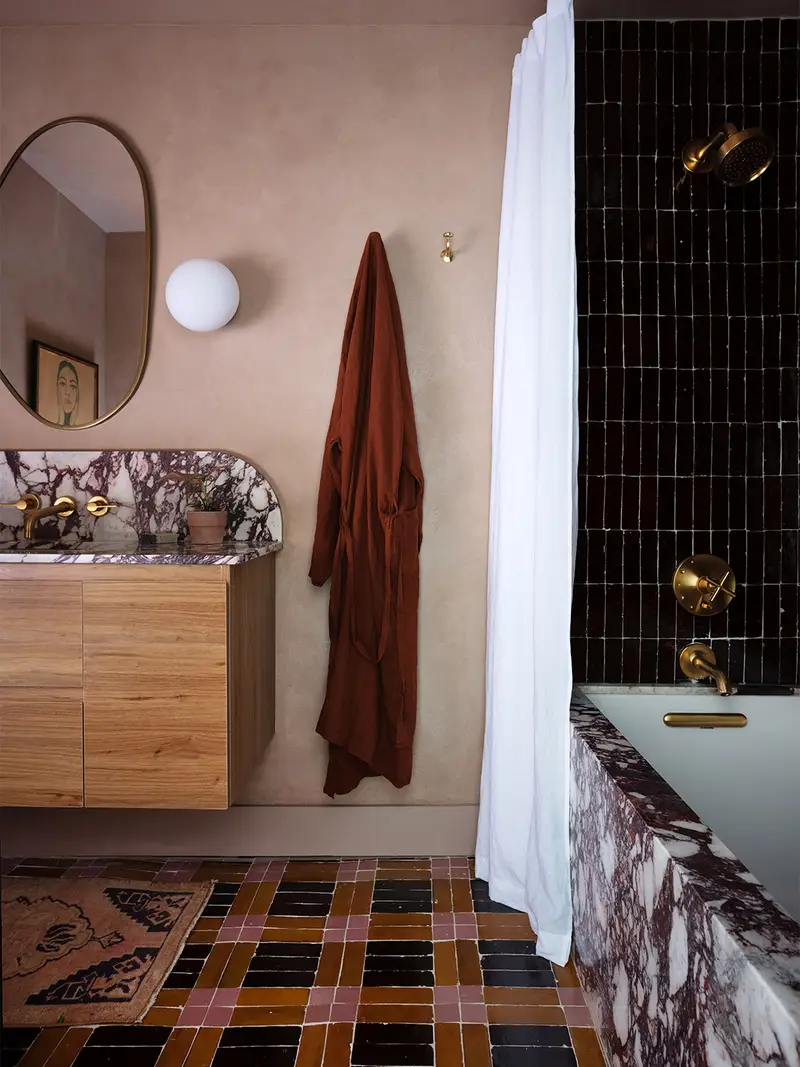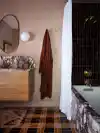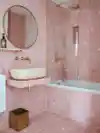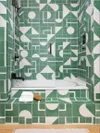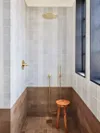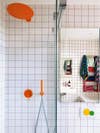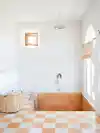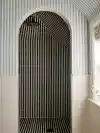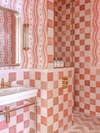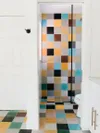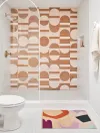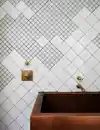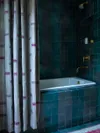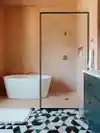Treat Your Shower Wall as a Mural, and 14 More Bathroom Tile Ideas That Make a Splash
Plaid, stripes, and checkerboard set the ceramic scene.
Published Nov 30, 2023 5:00 AM
We may earn revenue from the products available on this page and participate in affiliate programs.
While we appreciate the commonly dished-out design advice “just because you can doesn’t mean you should,” we believe that sometimes rebelling against the rules is necessary—especially when it comes to bathroom tile ideas. Because tile is that magical material that serves both function and form. So go ahead and be bold. Why choose one design if you can select a few—and create refreshing patterns with different sizes, shapes, and finishes? Or stick to a singular tile that makes a big impact when splashed over an entire space.
Keep reading for some of our favorite bathroom tile ideas that range from subtle (an earthy neutral stripe; a moody allover monochrome) to statement making (lilac grout; checks and squiggles).
Inject Cozy Cottage With Chic Character
Designer Whitney Romanoff of Meet West Studio dialed up the drama in this Arkansas cabin bathroom makeover using a rich, ’70s-inspired palette and plenty of texture. Between the handmade zellige arranged in a chic plaid pattern on the floor and the black tile lining the shower (not to mention eggplant-hued honed marble around the tub and atop the vanity), you have a space that nods to its history and surroundings while also feeling totally fresh.
Channel a Barbie-Approved Aesthetic
When Lee Thornley, founder of tile company Bert & May, designed his own home in northern England, he embraced the “just be brave” mantra he often shares with customers. He added tile to every single room, including allover pink in his daughter’s bathroom. The trick to not making this bathroom tile idea look too one-note? A sprinkling of starburst tile and brass finishes ensures it will age gracefully.
Transform Bath Time Into Playtime With a Fun Motif
Before you plot a gut reno for your bathroom, consider this: Shannon Wollack, founder-partner of Studio Life Style in L.A., was given the challenge to refresh the bedroom and en suite bathroom of a little boy who was transitioning into a new room to make way for his baby sister. Rather than start ripping out cabinetry, Wollack wanted to simply “jazz up” the lackluster space. She lined the entire niche in a modern geometric pattern that comes right over the tub face for a playful yet uniform look.
Add a Splash of Stripe (in an Unexpected Hue)
Taking tile risks isn’t just for maximalists. Designer Robert McKinley created an effortlessly elevated two-tone bathroom in this Montauk, New York, beach rental. To add warmth, he chose brass fixtures and Heath Ceramics’s Manganese tile (an unglazed brown clay option that “almost looks like dark cardboard”) for the floors and lower third of the wall. We’re calling it earthy nautical.
Get Groovy With the Grout
While we’re here to dig into bathroom tile ideas, we would be remiss to skip a grout shout-out. When renovating her family of four’s sole bathroom, London-based artist Leslie Kulesh wanted to build a space that could grow with them but still feel appropriate for their current stage in life: “bath mode.” For inspiration, she looked to the Memphis design movement and purchased Tres bathroom fixtures in various end-of-the-line colors; budget-friendly 4-by-4-inch white tile; and grout in unexpected shades of lilac, mango, light blue, and red (each for a different wall). Contained within a simple grid, the result is happy-making for all ages.
Showcase the Small But Mighty Mosaic
When hoping to make a real statement, most times people think bigger is better. But committing to a mini size in a bold color creates a surprising amount of impact, as you can see here in Brooklyn artist Caroline Z. Hurley’s Yves Klein Blue bathroom, where floor-to-ceiling mosaic tile is both energizing and zenlike. Elsewhere, natural materials and neutral colorways keep the spa vibe going.
Use Checkerboard Like a Neutral
We don’t care if forever-trending checkerboard is being dubbed Gen Z’s chevron. The easy-to-orchestrate tile combo has just enough of a cool edge while still staying timeless to make us start lining up the pattern in our own bathrooms. Look to designer Alex Boudreau’s sunken tub in the Todos Santos, Mexico, home she designed for her family as proof that the motif has staying power, especially in earthy terracotta and cream. Pro tip: Create even more contrast with your tub tile.
Go for a Tile and Wallpaper Trompe l’oeil
Plot twist: Layering the same pattern in different colors can actually make a smaller space look more streamlined. London-based interior designer Emma Ainscough covered the shower nook in a client’s home in dark blue-and-white–striped tile—and didn’t stop there. The same vertical lines appear in the form of French blue pinstripe wallpaper that carries all the way up the slanted ceiling, along with the tile, creating a bathroom brimming with visual interest (peep that arched shower door, too).
Be a “Capital M” Maximalist (Who Matches)
For the bathrooms at Kin House, an old Georgian manor-turned-events space in the English countryside, designers Lucy Sear-Barlow and Joshua Sear of Barlow & Barlow stuck to a strict palette—with a twist. The wallpaper, wall tile, and floor tile would be the same hues but in differing patterns. The effect is “actually quite calming and easy to digest,” says Sear-Barlow. Renovators take note: Starting with a wallpaper and color-matching the tile is not a hard feat to pull off, according to the designers. So if you can’t choose between two patterns, here’s your sign.
See the Beauty (and Budget Perks) in Randomness
Want a major tile moment but you’re running out of budget? That scenario plagued Kim Spradlin Wolfe while finishing her 400-square-foot guesthouse in San Antonio, Texas. She hit a Clay Imports warehouse sale but it didn’t have enough in one color—so she bought them all. As for curating a pattern, she turned the tiles upside down so that “when the guys installed them, they wouldn’t try to create a pattern. The 10 colors would just be random.”
Make Your Shower Wall an Eye-Catching Mural
As far as bathroom tile ideas go, this one is as clever as it is straightforward: Simply treat your shower wall as an oversize canvas. When designing her Portland, Oregon, home, interior designer Jessica Hansen covered her bathroom in rectangular matte white tile from Ann Sacks, then made one big geometric ceramic masterpiece with tile from Marrakech brand Popham Design.
Get Playful With Your Grid
Inspiration for this cool tile configuration struck during a visit to San Miguel de Allende, Mexico. “We saw two different scales of cobblestone collide, and that inspired us to take two very standard square tiles and blend them together,” explains Ben Work, who heads up San Francisco–based architecture and interiors firm Homework along with his wife, Susan. The pair opted for ceramic tile from none other than Home Depot—proving clever bathroom tile ideas don’t have to come with a hefty price tag.
Dive Deep Into a Moody Monochrome
The striped color variation in this deep teal guest bathroom might be subtle, but the glossy texture of the zellige Clé tile certainly is not. Designer Sally Breer worked with a couple relocating from New York City to Los Angeles to create a color-drenched home—bathrooms clearly included. Breer drew inspiration from the historic Union Station restaurant Fred Harvey Room, where the floor tiles were laid to mimic the look of textiles. An abstract-print shower curtain and rug add a burst of color to the moody mix.
Treat Your Bathroom Tile as Art
Look closely and you’ll see that the pattern in this shared kids’ bathroom isn’t wallpaper but a vibrant mosaic tile mural from New Ravenna inspired by the artwork of the Otomi people in central Mexico. “Their designs are filled with symbols of native flora and fauna, and you see this represented in the foxes and llamas prancing throughout,” says San Francisco designer Dina Bandman. To complement the colorful mural, Bandman opted for simple white subway tile on the lower half of the room, along with a red double ticking stripe as a snappy frame.
Consider a Luxe Tile Alternative
Would you believe that no tile was purchased in the making of this bathroom? Jaclyn Journey and Amanda Jacobs of Journey + Jacobs were inspired by a recent vacation to Greece when drafting up plans for the en suite bathroom in their friends’ new home. The only request: “They wanted something that felt like a hotel spa,” says Jacobs. A freestanding tub and peachy plaster walls already accomplish that brief—but the flooring made from cut-marble scraps in shades of black, white, pink, and emerald takes things to the next level.
